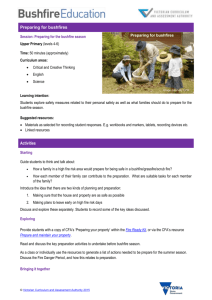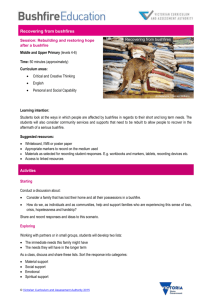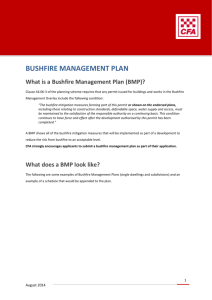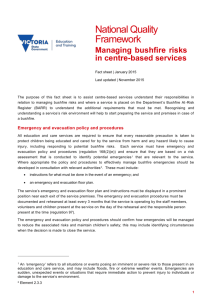Code Red FAQs
advertisement
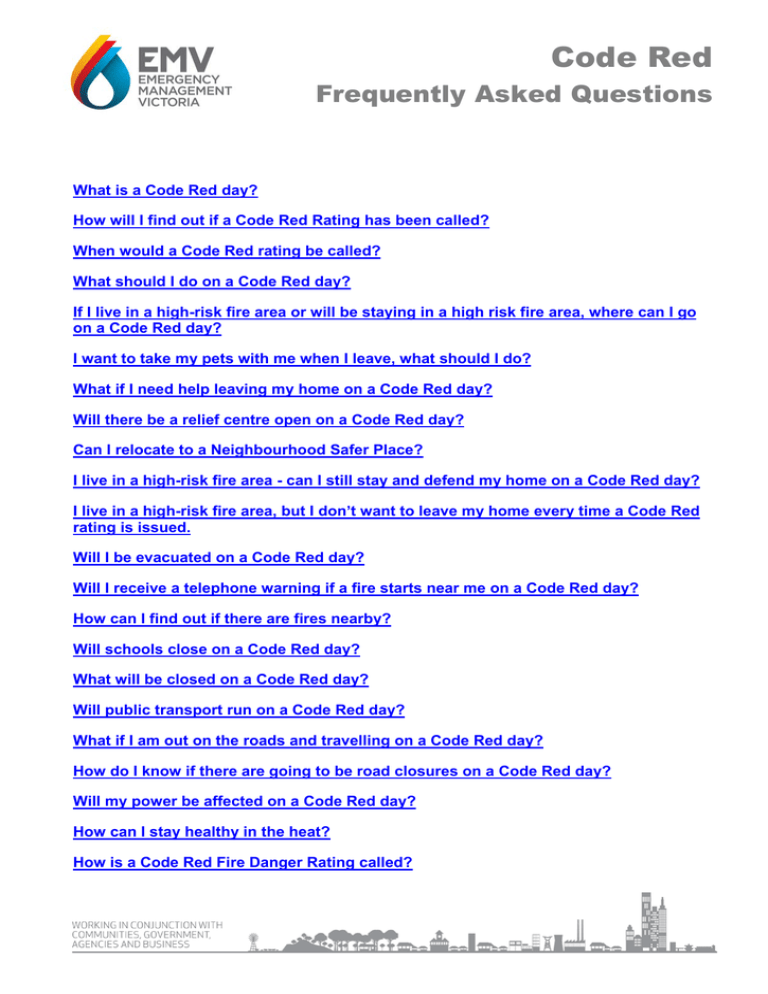
Code Red Frequently Asked Questions What is a Code Red day? How will I find out if a Code Red Rating has been called? When would a Code Red rating be called? What should I do on a Code Red day? If I live in a high-risk fire area or will be staying in a high risk fire area, where can I go on a Code Red day? I want to take my pets with me when I leave, what should I do? What if I need help leaving my home on a Code Red day? Will there be a relief centre open on a Code Red day? Can I relocate to a Neighbourhood Safer Place? I live in a high-risk fire area - can I still stay and defend my home on a Code Red day? I live in a high-risk fire area, but I don’t want to leave my home every time a Code Red rating is issued. Will I be evacuated on a Code Red day? Will I receive a telephone warning if a fire starts near me on a Code Red day? How can I find out if there are fires nearby? Will schools close on a Code Red day? What will be closed on a Code Red day? Will public transport run on a Code Red day? What if I am out on the roads and travelling on a Code Red day? How do I know if there are going to be road closures on a Code Red day? Will my power be affected on a Code Red day? How can I stay healthy in the heat? How is a Code Red Fire Danger Rating called? What is a Code Red day? Each day, the Bureau of Meteorology provides a Fire Danger Rating for each weather district in Victoria. You can find out what weather district you’re in and what the Fire Danger Ratings mean by visiting cfa.vic.gov.au Code Red (and Catastrophic in other Australian states) is the highest level of rating in Victoria and it signifies the worst conditions for grassfires or bushfires. A Code Red Fire Danger Rating means that if a fire were to start: • it will be uncontrollable, unpredictable and fast moving • fire services will find it difficult to put out • there is a high likelihood that people in the path of a fire will be killed or seriously injured • homes are not designed or constructed to withstand in these conditions - even the best prepared homes will not be safe • leaving high risk bushfire areas the night before a Code Red Day or early in the morning of a Code Red Day is the safest option for your survival – do not wait and see Conditions will also be extremely hot and windy and you need to take care of yourself in the heat. For more information see: How can I stay healthy in the heat? There is also an increased risk of power outages on Code Red days. Extreme weather and fires have the potential to damage or destroy electricity infrastructure, which may disrupt power supplies to your area. For more information see: Will my power be affected on a Code Red day? Back to Top How will I find out if a Code Red Rating has been called? A Code Red day will be called no later than 1.00pm the day before, however a Code Red can be called a number of days in advance which is why it is important to check the Fire Danger Ratings daily throughout summer. Fire Danger Ratings are published on the VicEmergency, CFA and Bureau of Meteorology websites. Fire Danger Ratings are also available through the FireReady app or by calling the Victorian Bushfire Information Line (VBIL) on 1800 240 667. If you are deaf, hard of hearing or have a speech impairment, you can contact VBIL through National Relay Service on 1800 555 677. People who are deaf or hard of hearing can also download the OpenAccess Alerts app. If you don’t speak English, call the Translating and Interpreting Service on 131 450. There are also automated Fire Danger Rating signs across Victoria. The digital signs display the Fire Danger Rating and provide people with an indication of how dangerous a fire would be. The automated system is in addition to the static Fire Danger Rating signs that CFA brigades manually update every day during the summer. Victorian fire agencies will use all these channels as well as media and advertising to let you know if a Code Red Rating has been called. Back to Top When would a Code Red rating be called? A Code Red day will be called no later than 1.00pm the day before, however a Code Red can be called a number of days in advance which is why it is important to check the Fire Danger Ratings daily throughout summer. Check the Fire Danger Ratings daily by visiting cfa.vic.gov.au or see: How will I find out if a Code Red rating has been called? Back to Top What should I do on a Code Red day? It is up to you to actively seek information, make decisions and act: • Every day during summer, check the Fire Danger Rating for the weather district you are in at cfa.vic.gov.au • If you live in a high-risk fire area, be ready to leave the night before a Code Red Day or early in the morning of a Code Red Day. Don’t wait and see if a fire will start – it may be too late for you to travel once a fire has started nearby. Know when you will leave, where you will go, how you will get there, when you will return and what you will do if you cannot leave. For more information on planning to leave early, including what to take and staying safe when you travel visit cfa.vic.gov.au/plan-prepare/leave-and-live/ • If you know of someone who might need help, for example, a person who is frail, elderly, or without transport, talk to them about how you can help them leave early. • Understand what the three different levels of warnings mean (Advice, Watch and Act, Emergency Warning). Don’t wait to receive an official warning. Fires can start quickly and threaten homes and lives within minutes. Check for warnings at emergency.vic.gov.au • If you get caught out during a fire, last resort options include Neighbourhood Safer Places and designated Community Fire Refuges. These are places of last resort when all other bushfire plans have failed. They may protect you and your family from direct flame and radiant heat, but they do not guarantee safety. In addition, travelling during a fire can be dangerous due to smoke and fallen trees and you may not be able to reach your destination. It is also important to remember that Community Fire Refuges are only opened once there is a significant fire in the area so you must have other last resort options identified. Back to Top If I live in a high-risk fire area or will be staying in a high risk fire area, where can I go on a Code Red day? You need to plan and leave early to a place which best suits your and your family’s own circumstances and needs. Consider taking a day trip to the nearest regional city where there are places to stay out of the heat such as shopping centres, cinemas etc. and you can remain in touch with family and friends. If you are taking pets you will need to think about where you are going and if it is pet-friendly. Check weather and fire conditions throughout the day and if they have eased, you may consider going home that night. If not, you may need to organise overnight accommodation such as a hotel, caravan park or hostel or stay with family or friends. Back to Top I want to take my pets with me when I leave, what should I do? If you’re planning to leave early, take into consideration what you’ll do with your pets, how you’ll transport them and what they’ll need. Think about where you’ll go and if that place is pet-friendly. Prepare an emergency kit that includes food and medications as well as leads and cages for transportation. Confine pets and animals you are taking with you early so they are close by when you need to leave. Have transport ready. Always have water and shade available for your animals. Remember that vehicles can get hot very quickly so don’t leave them unattended in your car. Make appropriate arrangements for large animals and any animals being left behind on the property. Livestock and horses need to be removed early or moved to a low-risk area such as a ploughed paddock. Make sure they have enough food and water for five days. Don’t cut external fences or leave gates open onto roads as animals can create a road safety risk. See depi.vic.gov.au/fire-and-emergencies/animals-in-emergencies for more information on preparing for animals in emergencies. Back to Top What if I need help leaving my home on a Code Red day? If you rely on others for care or support, and you live in a high-risk bushfire area, then leaving early, well before a fire-risk day, is your only safe option. You shouldn’t wait for warnings or evacuations. Organise reliable transport, and make sure you have a safe place to go, well away from any high-risk areas. Tell your family, friends and neighbours where you’ve relocated to, and that you’re safe. If you need help to plan to leave early, ask your family, friends or neighbours. You can also complete a Red Cross Bushfires – Preparing to Leave Early Plan. Download this free plan from the CFA website at cfa.vic.gov.au or request a copy from the Victorian Bushfire Information Line on 1800 240 667. If you know of a friend or family member who might need extra care or support, check in with them to see if they’ve made plans for leaving early or if they need assistance. Back to Top Will there be a relief centre open on a Code Red day? Emergency relief centres are typically only opened once the location and scale of an emergency is known. Back to Top Can I relocate to a Neighbourhood Safer Place? Neighbourhood Safer Places (NSPs) are a last resort option only. They are locations that may provide some protection from direct flame and radiant heat, but they do not guarantee safety. Travel to a NSP is likely to be very dangerous. Only go to a NSP in the event of a bushfire and if all other plans have failed. Back to Top I live in a high-risk fire area - can I still stay and defend my home on a Code Red day? Leaving high-risk bushfire areas the night before or early on the day of a Code Red rating is your safest option – do not wait and see. Code Red signifies the worst conditions for bushfires and grassfires and homes are not designed or constructed to withstand fires in these conditions. The safest place to be is away from high risk bushfire areas. There is also an increased risk of power outages in these kinds of conditions. If you are still at home and your power goes out, it could affect your safety and your ability to access important information or call for help if you need it. Fire agencies would ask people to think very carefully about the impact on their families if caught in a fire or if staying to defend. Even well prepared homes are not safe and as well as the extreme physical demand, you are also likely to suffer emotional stress and trauma both during and after the fire. Back to Top I live in a high-risk fire area, but I don’t want to leave my home every time a Code Red rating is issued. Code Red days are very rare and very serious. These are the worst conditions for a bushfire or grassfire. Leaving high-risk bushfire areas the night before a Code Red day or early in the morning of a Code Red day is the safest option for your survival – do not wait and see. Back to Top Will I be evacuated on a Code Red day? Leaving high-risk bushfire areas the night before a Code Red day or early in the morning of a Code Red day is the safest option for your survival – do not wait and see. The safest place to be is away from high-risk bushfire areas and by leaving early, you will reduce your risk of being caught out in a fire. Evacuations only occur in situations where, already there is no other option and it can be done safely. You should never rely on being evacuated or receiving an official warning. It’s important to have access to more than one source for information and fire warnings. Stay informed by listening to ABC local radio, commercial and designated community radio stations or Sky News TV, by phoning the Victorian Bushfire Information Line (VBIL) on 1800 240 667, checking the VicEmergency website at emergency.vic.gov.au, by downloading the FireReady App and through CFA’s Twitter (@CFA_Updates) and Facebook (cfavic) accounts. You need to consider your relocation options on fire-risk days - choose where you will go and what you will do during the day to suit your circumstances. Back to Top Will I receive a telephone warning if a fire starts near me on a Code Red day? You should never rely solely on receiving an official warning in an emergency. You need to monitor conditions via a number of channels to receive information and warnings. It is your responsibility to stay informed and make decisions about your safety. Fires can start and spread quickly, faster than a warning can be issued which is why you need to be aware of local conditions and your surroundings. In some situations where there is immediate danger, a telephone alert may be sent to your landline or mobile phone using the national telephone alerting system, Emergency Alert. When you receive a telephone alert you must follow all instructions given, and stay informed by checking official warning sources. For a number of reasons, technology can also fail so do not rely solely on your phone. Back to Top How can I find out if there are fires nearby? • • • • • visit emergency.vic.gov.au download the FireReady app tune in to ABC local radio, commercial radio, designated emergency broadcasters or Sky News call the Victorian Bushfire Information Line on 1800 240 667 check out CFA’s Twitter (@CFA_Updates) and Facebook (cfavic) accounts. Back to Top Will schools close on a Code Red day? Schools, kindergartens and licensed child care centres identified as being at high fire risk and on the Department of Education and Training’s Bushfire At-Risk Register (BARR) will close on Code Red days. Student transport bus routes co-ordinated by schools listed on the BARR and bus routes which travel through the Code Red area will also be cancelled. Schools and services not on the Department of Education and Training’s Bushfire At-Risk Register will remain open, unless directly threatened by fire or another emergency. As much notice as possible will be given for potential Code Red closures but parents and carers should be aware that this is not possible in all circumstances. Advice will be provided to you directly by your school, kindergarten or child care centre. When a school or children's service is closed for Code Red, no staff will remain on site and all out-ofschool care programs in that area, including vacation, before and after school programs, e.g. camps and excursions, will be cancelled. For more information, visit education.vic.gov.au Back to Top What will be closed on a Code Red day? A number of government departments and agencies are likely to suspend services on Code Red days in high-risk fire areas due to dangerous fire conditions and resources being committed to emergency preparedness and response. Schools, kindergartens, licensed child care centres that have been identified as being at high fire risk and on the Department of Education and Training’s Bushfire At-Risk Register will be closed on Code Red days. Affected student transport routes will also be closed. For more information, go to education.vic.gov.au or see: Will schools close on a Code Red day? Roads may be closed due to smoke and fire. Check road closure information before travelling on Code Red days by visiting traffic.vicroads.vic.gov.au or call 13 11 70. For more information see: What if I am out on the roads and travelling on a Code Red day? High bushfire risk parks and forests will close on Code Red days. Visit parks.vic.gov.au call 13 19 63 for park closure information. or Public transport may be affected by the heat and V/line trains may travel slower than normal speeds for safety reasons. For more information see: Will public transport run on a Code Red day? Businesses and tourist attractions may be closed on a Code Red day. Seek information from locals, your host or an accredited Visitor Information Centre who may be able to suggest alternative holiday activities and provide local bushfire information. Back to Top Will public transport run on a Code Red day? On days where the temperature is forecast to rise above 36 degrees, V/Line trains are forced to travel at slower speeds for safety reasons. This is due to extreme heat in the steel that can cause the steel tracks to expand. The speed reduction can vary, but you should allow for extra travel time, particularly in the peak of the heat which is generally between midday and 8.00pm. To ensure evening peak trains can depart Melbourne on time, some afternoon trains are replaced with buses. Visit vline.com.au or ptv.vic.gov.au for more information. Back to Top What if I am out on the roads and travelling on a Code Red day? You should avoid all unnecessary travel to high-risk bushfire areas within the weather district for which a Code Red has been called. Victoria’s high-risk bushfire areas are typically heavily forested, have thick bush or long, dry grass, or are coastal areas with lots of plant life. If you are staying in a high-risk fire area, leaving early is the safest option. Leave the night before or early on the day of Code Red. Keep monitoring warnings and signs of fire activity, and return only when it is clearly safe to do so. Visit a low-risk area such as large shopping complex or the central business district of a regional city but ensure you have planned according to your own personal circumstances and needs. Your host or an accredited Visitor Information Centre may be able to suggest alternative holiday activities on high risk days and provide local bushfire information. Make sure you plan ahead and stock up on food and water supplies, as some local small businesses may not be open on a Code Red day. Before you hit the roads, make sure you’re aware of the local conditions and any fires in the area. When you are on the roads, make sure you have plenty of water for your car and enough petrol to get where you need to go. Go to the VicRoads website, alerts.vicroads.vic.gov.au, for current road closure information before you travel. When in the car, listen to your local emergency broadcaster for up-to-date information. Always observe road closure signage. You can call 13 11 70 to ask about the status of a road if you cannot get access to the internet. Check for fire warnings by visiting emergency.vic.gov.au, following @CFA_Updates on Twitter, liking the CFA Facebook page (cfavic), using the FireReady app, calling the Victorian Bushfire Information Line on 1800 240 667, or listening to ABC Local Radio or other emergency broadcasters. Back to Top How do I know if there are going to be road closures on a Code Red day? Always check the status of roads before travelling on Code Red days. Bushfires can move quickly and affect roads with very little warning so avoid travel in fire-affected areas (or areas vulnerable to fires) if you can. Only travel if you need to and make sure you have plenty of water for your car and enough petrol to get where you need to go. Make sure you plan ahead and stock up on food and water supplies, as local small businesses may not be open on a Code Red day. Go to the VicRoads website, alerts.vicroads.vic.gov.au, for current road closure information before you travel. When in the car, listen to your local emergency broadcaster for up-to-date information. Always observe road closure signage. You can call 13 11 70 to ask about the status of a road and you cannot get access to the internet. Back to Top Will my power be affected on a Code Red day? There is an increased risk of power outages on Code Red days. Extreme weather and fires have the potential to damage or destroy electricity infrastructure, which may disrupt power supplies to your area. Leaving high-risk bushfire areas the night before or early in the morning of a Code Red day is your safest option – do not wait and see. If you are still at home and your power goes out, it could affect your safety, as well as your ability to access important information or call for help if you need it. If you have decided to stay and defend your home, it is important to be prepared and know what to do if your power goes out. Make sure you have access to: • a torch or battery-operated light • • • • a phone that doesn’t rely on electricity (such as a charged mobile phone) a battery powered radio for news and updates fresh water, if you rely on an electric pump for water a list of important emergency contact numbers For more information about preparing for power outages, visit: energyandresources.vic.gov.au/poweroutage-guide Back to Top How can I stay healthy in the heat? • • • • • • • • • • • • Be sensible in the heat – it can make anybody sick. Put off outdoor activities until the heat event is over. Check on friends and neighbours, especially if they are elderly or alone. Drink plenty of water, even if you don’t feel thirsty. If you can’t be in air-conditioning, try wet towels and cool showers, a fan and drink cool water. Stay cool indoors especially around the hottest part of the day. Head for a cool indoor spot like a public library, shopping centre or cinema but plan according to your own personal circumstances and needs. Don’t leave kids, pets or anyone else in the car. Dress for the heat. Loose, light coloured clothes are best. Eat smaller, cold meals more often. For 24-hour health advice contact NURSE-ON-CALL on 1300 60 60 24. For more information on heat health and to download the Better Health Channel app heat alerts visit betterhealth.vic.gov.au Back to Top How is a Code Red Fire Danger Rating called? A Code Red day in Victoria – or Catastrophic Fire Danger Rating in other Australian states - is called using the national Fire Danger Rating system – a six-tiered ratings system which tells you how dangerous a fire would be if one started. The rating is your trigger to act and helps you to plan and prepare according to your own circumstances. Ratings are determined using Bureau of Meteorology weather forecast data in combination with other environmental conditions assessed by fire agencies, such as information on fuel loads. The ratings are produced daily and are shown for up to four days in advance. The higher the rating, the more dangerous the conditions. A Fire Danger Rating of ‘Code Red’ is the highest level of rating in Victoria. It signifies the worst conditions for grassfires and bushfires. Code Red ratings are only called for days of extraordinary and extremely dangerous conditions. In Victoria, a Code Red day is called by the Emergency Management Commissioner. The Emergency Management Commissioner makes a decision in close consultation with fire agencies and relevant departments, as well as the Bureau of Meteorology. When determining a Code Red day, the Emergency Management Commissioner will take into account weather, fuel and other environmental conditions at the time and a number of other factors including fires which may already be burning, particular areas at risk and the time of year as there may be more people holidaying and moving around the state. Back to Top
